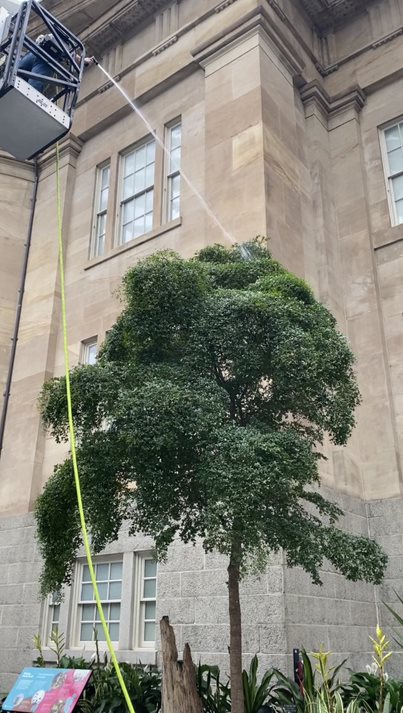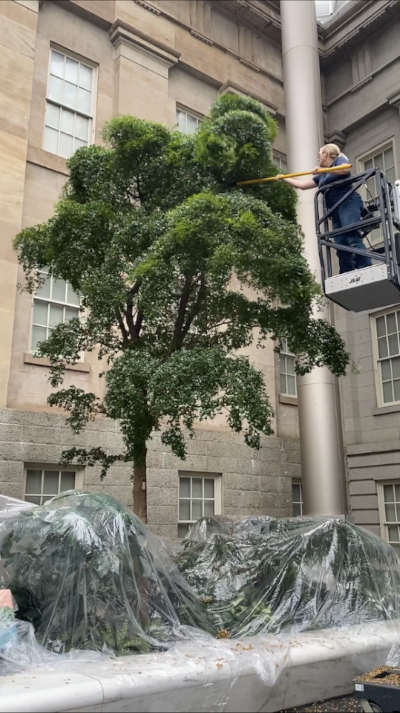Keeping Healthy Trees in an Indoor Space

Visitors to the Kogod Courtyard at the Smithsonian American Art Museum and National Portrait Gallery most certainly notice the 25-foot-tall trees that inhabit and beautify this wonderful indoor space between the two museums. These twelve trees, all part of the Smithsonian Gardens Tree Collection, answer to the common name ‘Shady Lady’ black olive and belong to the tropical species Terminalia buceras in the family Combretaceae. They, as well as all of the tropical plantings in the glass-enclosed courtyard, are cared for by a team of horticulturists and arborist from Smithsonian Gardens.
What does it take to keep these trees thriving in this unique indoor space?
We know that for centuries humans have been bringing the outside in, brightening up interior spaces by incorporating plants into homes and offices. Despite how much we love having nature indoors, however, and the fact that we call them houseplants, we should not forget that plants are adapted to the outdoors and are not truly meant to be inside. All plants need the basics (water, sunlight, and nutrients) to grow and stay healthy, and as horticulturists it is our job to provide these in our routine cultural care regardless of the environment in which they grow. And while it is true that an atrium or courtyard enclosed by a glass ceiling provides appropriate conditions for tropical plants when it comes to light amounts and temperatures, we run into the challenge that plants not exposed directly to the outside elements lack the effects of other important phenomena like wind and rain.
Why are wind and rain important and how do we mimic them for indoor trees?
When grown indoors, plants collect a layer of dust on their foliage since there is no rain to wash it off and keep them clean. Dust has a negative effect on plants by blocking and reducing the amount of light that reaches the leaves which diminishes the efficiency of photosynthesis, the process by which a plant produces its own food. Respiration and transpiration are also impacted since the gas exchange cells on leaf surfaces are also blocked by dust particles. Plants stay healthier when they are clean and can metabolize at optimal levels; this also has the added benefit of helping to keep them pest-free.

At the same time, indoor environments don’t have very strong air circulation which causes indoor plants to miss out on an element that helps strengthen them, namely their movement caused by the wind. Gentle swaying by wind is known to play a role in making trees sturdier by stimulating the production of stress wood which has a different tissue structure and composition that helps the tree maintain its structural integrity and grow stronger over time. Movement of the canopy can also help groom the tree by removing dead leaves and small branches.

Every six months we manually mimic wind and rain in the Kogod Courtyard by performing our official “Shake & Wash” of the black olive trees. This task takes a crew of four horticulturists about four hours to complete. The shaking and washing get done at the canopy level from a vertical lift. Using a pole topped with a hook, we gently pull and sway the branches and brush the foliage. Plantings underneath the trees get covered with a thin sheet of plastic to make the collecting and removal of any dead leaves shaken from above easier. Following the “shake” portion of the process, the trees are thoroughly hosed down with a watering wand set on alternating “shower” and “jet” pressure. The end result is cleaner, stronger and healthier trees.
The practice of movement stimulation and the dusting of leaves is recommended for all plants grown indoors. Most likely you will not need a lift, long pole, and a hose to do this in your home or office, but your hands plus a soft rag or duster will do. No matter the tools you use, make sure to provide some “wind and rain” for your houseplants from time to time. They’ll love you for it!

